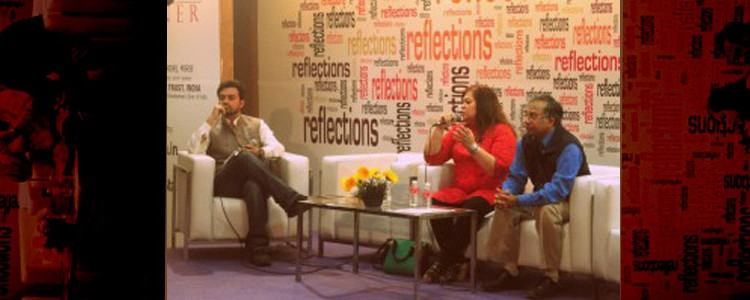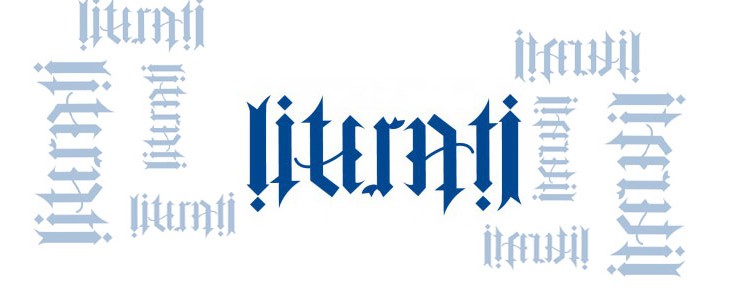Guest post: Historicizing Myths, Mythologizing History, Sami Ahmad Khan
 ( On 21 February 2014, during the World Book Fair, New Delhi, Sami Ahmad Khan was in conversation with thriller writer Aroon Raman and Sangeeta Bahadur. Aroon Raman had just released his latest novel, a historical thriller – The Treasure of Kafoor and Sangeeta Bahadur had published Jaal. Both the authors are published by PanMacmillan India. Here is an account of the event sent by Sami Khan. )
( On 21 February 2014, during the World Book Fair, New Delhi, Sami Ahmad Khan was in conversation with thriller writer Aroon Raman and Sangeeta Bahadur. Aroon Raman had just released his latest novel, a historical thriller – The Treasure of Kafoor and Sangeeta Bahadur had published Jaal. Both the authors are published by PanMacmillan India. Here is an account of the event sent by Sami Khan. )
Historicizing Myths, Mythologizing History
We’re a nation built around myths. Or maybe we’re just a myth built around a nation. Whatever the case may be, can we ascribe historicity to myths and study such mythologies as running parallel to certain socio-historical processes spawned by the material realities of their times? More importantly, where does mythology end and where does history begin?
Similar questions raged in my mind as I strode towards the Authors’ Corner at Hall 10-11 of Pragati Maidan on February 21, 2014. The Delhi World Book Fair 2014 was in full swing and I was moderating a session scheduled to begin at 2.30 pm. Wading past Siren-esque stalls (that featured books on sale) and Charybdian crowds (replete with delightfully engrossed bookworms), I odysseyed to my destination to converse with two brilliant minds and wonderful writers – Sangeeta Bahadur and Aroon Raman.
I knew Aroon Raman from before, having read him earlier with much gusto. Raman had obtained his masters degree from JNU, Delhi, an MBA from the Wharton School, University of Pennsylvania, and was now an entrepreneur based out of Bengaluru. The Shadow Throne was Aroon Raman’s debut – an electrifying thriller involving the R&AW, ISI and an India-Pakistan nuclear standoff. The Treasure of Kafur, his second published novel, was incidentally written first. A fast-paced, historical thriller set in Mughal India, the novel fictionalized the treasure of Malik Kafur being sought after by contemporary figures such as Akbar, Rana Pratap, and (quasi-historical?) characters such as Asaf Baig (of Khandesh) to wage war for the control of Hindustan.
 On the other hand, it was the first time I was going to meet Sangeeta Bahadur, writer of Jaal and Vikraal. I was told she had graduated from Sophia College (Mumbai), an institution I admire a lot. Bahadur is an Indian Foreign Service officer who is currently posted as the Director of the Nehru Centre, London. If Raman writes about politics, coming-of-age, and action, Bahadur too weaves a deep, engrossing web of inner conflict – this one around mythological fiction. She utilizes Indian spirituality and metaphysics, fuses them with the world created by her own mind, and comes up with a whole new mythos. Bahadur’s Jaal is the first of a trilogy – set in a syncretic, eclectic past where a young boy must train himself to become the ultimate fighting machine to combat the forces of Maya, the novel is a more spiritual version of LOTR set in a land that resembles India. A sequel called Vikraal will be out soon.
On the other hand, it was the first time I was going to meet Sangeeta Bahadur, writer of Jaal and Vikraal. I was told she had graduated from Sophia College (Mumbai), an institution I admire a lot. Bahadur is an Indian Foreign Service officer who is currently posted as the Director of the Nehru Centre, London. If Raman writes about politics, coming-of-age, and action, Bahadur too weaves a deep, engrossing web of inner conflict – this one around mythological fiction. She utilizes Indian spirituality and metaphysics, fuses them with the world created by her own mind, and comes up with a whole new mythos. Bahadur’s Jaal is the first of a trilogy – set in a syncretic, eclectic past where a young boy must train himself to become the ultimate fighting machine to combat the forces of Maya, the novel is a more spiritual version of LOTR set in a land that resembles India. A sequel called Vikraal will be out soon.
How do we comprehend, decode, and analyze mythological and historical fiction written by people from such varied backgrounds and visions? As Bruce Lincoln defines myth as “ideology in narrative form,” one of the first questions I asked Bahadur and Raman was how mythology and history interacted in their minds and in their texts – and if they chose their respective genres to enable them to fuse their narrative styles with the content, i.e. what (and how) they wanted to say.
Their answers were complementary to each other (an aspect that continued throughout the duration of the conversation) – both made me realize something I had so criminally overlooked – writers make genres, genres do not make writers. Both regarded writing as an act of unbridled creation – unfettered by the limitations of any genre. Yes, they wrote about mythology and history, but as fiction writers, they perceived both as two sides of the same coin. Both clarified that rather than being true to the narrative conventions of any genre, culture or style, they rather wanted to be true to the reader and to themselves. The end-result, for both Bahadur and Raman, was to use any template close to them that could give the readers a fast-paced, layered and interesting narrative for the reader.
I then raised the question of spirituality – both Bahadur and Raman draw upon Indian classical traditions. While Bahadur’s primary lens to synthesize different mythologies and traditions and further the plot is primarily aastik in its outlook, advaita-vedanta in particular (which becomes explicit at times), Raman has his implicit groundings in the naastik traditions of Buddhism. Both Jaal and Kafur have a dense spiritual/philosophical subtext that not only drives the plot further but also seeks to define why characters do what they do. It is their belief in fixed ideological structures that make these characters come alive – and shapes their behavioral patterns.
For individual questions, I asked Aroon Raman why his second book was markedly different from his first, and why he chose to jump across genres despite the commercial success of his debut venture. The Shadow Throne is a contemporary military/political thriller, whereas The Treasure of Kafur is historical fiction. Apart from reiterating that genres do not matter for a creator, and that thoughts and ideas rarely come to writers filtered and censored via the sieve of pre-existing notions and genres, Raman made me realize that the end-goal was to write a book that was fun to read, and that a writer should concern himself with creating without worrying about genre pigeonholing – and that the two books weren’t that different after all. Both his books have a central character caught in hostile surroundings and his constant striving to prevent evil from triumphing – the temporal dislocation does little to blunt this action-oriented narrative.
I then asked Bahadur that while Raman may write about ISI and RAW, she, as a serving government officer, cannot. So was this mythological fiction, replete with betrayals, realpolitik, machtpolitik, coups, warring kingdoms and political federations, actually a political allegory meant for the contemporary times? In response, while Bahadur graciously acknowledged that although historicity did shape some parts of Jaal, the novel was in no way a political allegory. She was not merely utilizing an already established ideological narrative, but creating a whole new ideating philosophy, politics, sociology and world in her head.
The two also talked about how, as writers, both were aware of the social implications of the outlooks of their characters. Raman talked about spending time in Tihar as a student-activist (and a member of the JNU Students’ Union) almost 30 years ago – but then accepted that now he was a capitalist entrepreneur, though that did not render him politically unconscious or reactionary. His characters, to prove a point, are strongly feminist, anti-casteist, pro-hoi polloi, progressive, and anti-parochial – people who speak up for the masses. Bahadur also has some similar characters who seek unity in diversity (rather than differences), and raise their voices against injustices and hegemony. This forms the basis for a layered characterization by both the writers.
The session concluded with both Sangeeta Bahadur and Aroon Raman giving the audience some tips about writing fiction. They urged budding writers to break free from the shackles of form and classification – and just go write a good story that was fun to read and did not spoon feed the reader what the writer thought.
It was great talking to these two thinkers – they just proved that to write one sentence, one must think an hour at least! Lastly, all this is based on my understanding on what the writers said and meant, not to mention a failing short-term memory – it may not wholly coincide with what they actually meant, but I hope I’ve been able to be true to their ideas.
I look forward to more such opportunities.
Sami Ahmad Khan read Literature at Hindu College, Delhi University, completed his master’s in English at Jawaharlal Nehru University (JNU) and then went to the University of Iowa, USA, on a Fulbright grant. Currently, Sami teaches at IIT-Delhi, apart from being a Doctoral Candidate at JNU, where he is working on Techno-culture Studies. He has engaged in theater, writing, and teaching. His debut thriller Red Jihad won the “Muse India Young Writer (Runner-Up) Award” at the Hyderabad Literary Festival 2013 and Ministry of Human Resource Development/NBT’s “National Debut Youth Fiction Award – Excellence in Youth Fiction Writing” at the Delhi World Book Fair 2013. He is now working on a SF sequel to Red Jihad. He can be reached at [email protected]
( On Sunday, 24 August 2014, Sheila Kumar wrote a lovely review of the novel in the Hindu Literary Review – http://www.thehindu.com/books/books-reviews/more-than-just-a-treasure-hunt/article6344815.ece . On 26 August 2014, Aroon Raman will be in conversation with Sumeet Shetty at Literati, SAP Labs Book Club, Bangalore. http://bit.ly/1pazgf4 )
26 August 2014




